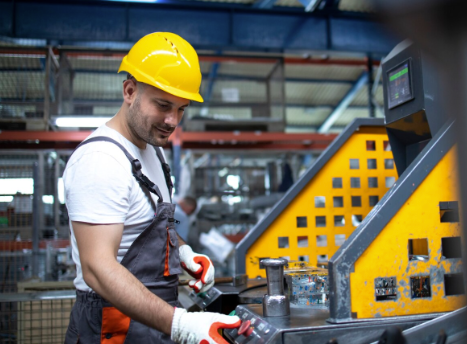Across Canada, metal fabrication shops are changing in ways as strong as any press brake or torch: automation. With intelligent systems, sensors, and robots at the forefront, these advanced shops are not only bending, cutting, and welding—they’re adapting, thinking, and transforming.
This revolution isn’t about substituting humans—it’s about rethinking the way work is being accomplished. With machines as their assistants, Canadian fabricators are getting quicker, more precise, safer, and more reliable. That is, automation is turning the impossible into the normal and the normal into the spectacular.
Robots That Do More Than Weld
The vision of welding sparks under the control of a robot arm is maybe the first that one would think of—but metal fabrication automation has much more distant prospects. New robot systems are multi-purpose powerhouses, accomplishing more than mere handling of hot equipment.
- Press brakes for perfect bends, operated automatically
- Plasma and laser cutters operated robotically to cut shapes unparalleled
- Material-handling arms loading and unloading in idle time
- CNC machines that cut with flawless precision and no margin for mistake
- Robots for polishing, deburring, and finishing to an exact gleam
- Welding robots that correct their path in real-time, adjusting on the fly
- Machines that learn from sensor feedback and adjust their movement
The Brain Behind the Brawn: Software
Hardware takes center stage, but it’s software that powers this next wave of fabrication. Canadian factories are spending money on digital brains that plan, manage, and even anticipate what comes next.
- CAD/CAM systems for maximizing design-to-manufacturing
- Simulation software that reveals weak points before a cut
- Cloud-based production tracking for real-time job status
- Machine learning systems that get smarter with every part produced
- Downtime prediction software to minimize downtime
- Inventory software that communicates directly with cutting machines
- Digital twins that simulate entire shops to create smarter layouts
Precision Meets Speed in Laser Cutting
Laser cutting was revolutionary enough. Automation took it to the next level. Machines now load, cut, sort, and even stack—all of it with little or no human hand. The payoff? Clean cuts, quick turns, and no guessing.
- Automated nozzle changers for varying thicknesses
- Vision systems for material recognition
- Sensors that provide the optimum focal length
- AI-powered path optimization
- Robotic arms to automatically pull out cut parts
- Scrap separation done automatically
- Lights-out laser cutting without an operator in sight
Smart Bending with Fewer Guesses
Press brakes used to depend so heavily on operator skill. Nowadays? Machines measure and adjust in real time. That means fewer test bends, less rework, and quicker cycle times—even for intricate geometries.
- Angle sensors to validate each bend in real time
- Automatically changing tooling for changing thickness
- Laser measurement of part location
- Back gauge automation for speed and precision
- Robotic loading and rotation of parts
- AI automatic springback compensation
- Real-time compensation without machine shut-down
Material Handling Goes High-Tech
Moving metal safely and efficiently used to be a labor-heavy task. But automation is where it’s headed, and robots are lifting the heavy loads while conveyors sort the high-tech way.
- Gantry lifts that move massive sheets with ease
- Robotic delivery carts coasting on custom routes
- Pick-and-place automation and gravity-fed racking
- Raw stock scanners that identify and sort stock
- Conveyors that can accelerate and decelerate to match workflow
- Automated guided vehicles (AGVs) mapping the floor
- Collision-avoidance sensors to safeguard workers and equipment
Real-Time Quality Control
Inspection is no longer an independent step—it’s integrated into the process. With robotics and AI, Canadian shops are catching defects early, enhancing accuracy, and removing scrap in real time.
- 3D scanning arms to confirm dimensions
- Vision systems that identify flaws at production
- Laser profiling of edges and cuts
- Computer comparison to CAD plans
- AI that learns and detects anomalies
- Feedback loops that resynchronize cutting paths during the job
- Touch-free surface scanning with hyperspectral cameras
Intelligent Design Safety
One of the best things for automation? Less injury. Repetitive, risky, dirty jobs are done by machines. Employees are in secure positions and do higher-level work.
- Strong robot cells for cutting and welding
- Light curtains and emergency stop with AI release
- Predictive systems that provide advance warnings of hazardous trends
- Automating sharp scrap cleaning devices
- Proximity sensors to slow down robots getting near human workers
- Heavy lifting taken out of the way by robotic lifters
- Real-time monitoring of the environment for temperature and fumes
Upskilling Workers, Not Replacing Them
Rather than replacing workers, automation is about transforming and educating them. Canadian fabricators are investing in training programs as capital expenditures that turn operators into programmers, inspectors and analysts, and machinists and system designers.
- Robotic programming certification courses
- Technology training on site by machine vendors
- Cross-training between mechanical and digital roles
- Technology college and university alliances
- Learning new processes through simulation
- Extramuraling to automation management
- Designing hybrid jobs which blend hands-on and technical competencies
ROI of Going Robotic
Automation doesn’t come inexpensive—but ROI is well worth it. From greater output to reduced errors, Canadian fabricators are realizing tangible gains that compound year after year.
- Increased throughput with same-sized staff
- Increased yield per sheet due to nest accuracy
- Reduced material waste and scrap
- Conservation of energy due to efficient systems and motors
- Reduced downtime due to predictive maintenance
- Lower injury-related cost
- Increased business due to turnaround time
Powering People Through Precision Technology
At its most fundamental level, automation in Canadian metal fabrication is a question of unleashing human potential—not replacing it. In a modern metal fabrication shop, machines do repetitive, dangerous work, freeing skilled workers to concentrate on innovation, accuracy, and leadership. The future of fabrication is in this partnership—where technology powerfully empowers people, and progress is constructed by both.








